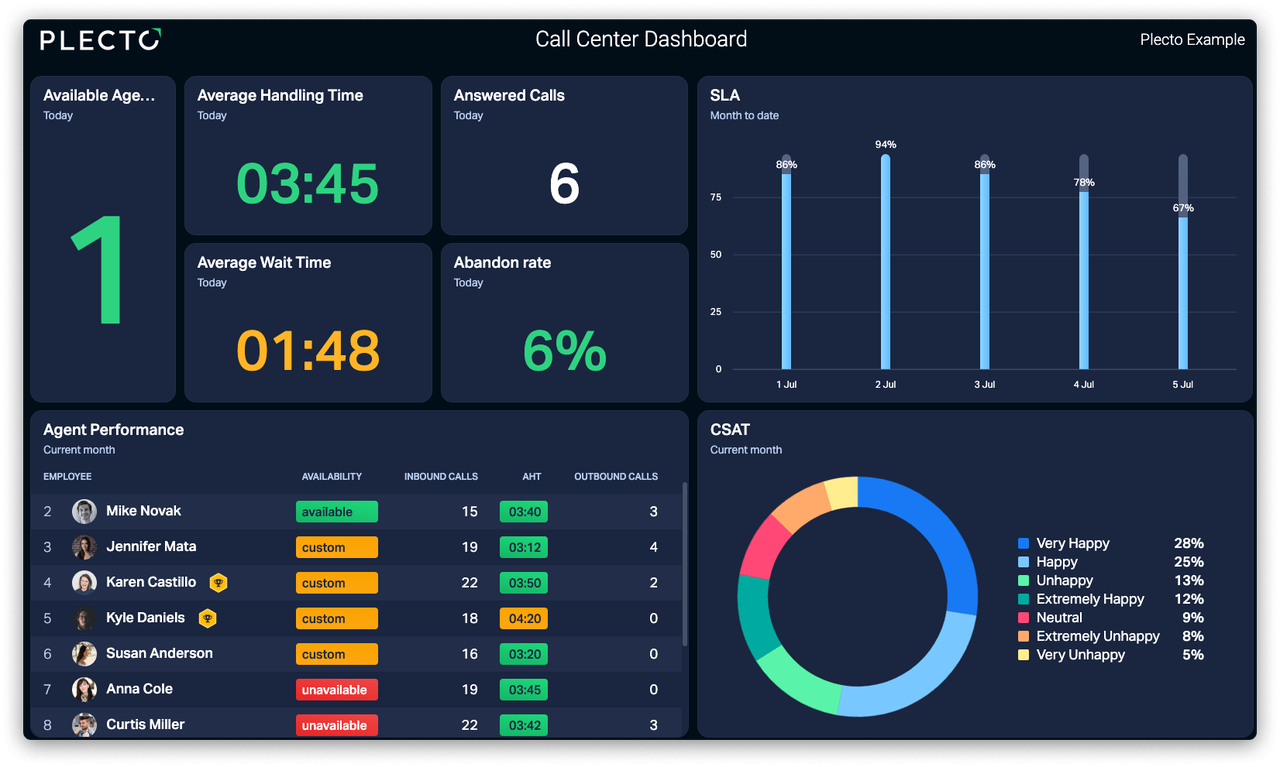Customers’ service expectations are higher than ever – and so are the stakes for companies wanting to maximize customer retention. As a result, competitive companies looking to minimize churn are increasingly implementing service level agreements (SLAs) to set expectations and hold themselves accountable.
Call center SLAs are essentially a company’s promise to its customers to provide a certain standard of service.
Read on to discover how to create a service level agreement, which metrics to include, and six ways to meet or exceed your call center SLAs.
How to Set Up a New Service Level Agreement
Whether they’re shared with customers or just internally, service level agreements help customer service teams track whether the service they’re providing meets the company’s standards.
These five steps will set you on the path to successfully implementing a new call center SLA:
- Define clear objectives that are measurable, achievable, and aligned with your company’s overall customer support strategy.
- Set realistic targets based on current performance, industry benchmarks, and your team’s capabilities.
- Establish timeframes for responding to different types of inquiries – consider things like complexity and urgency while attempting to minimize customer effort.
- Share the metrics with your team to ensure that they understand the targets and their role in achieving them.
Monitor your team’s performance to evaluate whether they’re achieving the targets; if not, why not; and how you might be able to further optimize service levels.
5 Common Metrics for Call Center SLAs
When establishing a new call center SLA, it’s important to consider your customer service goals, your customers’ needs and expectations, and your team’s capabilities. As you set your targets, it’s crucial to consider your staffing levels, inquiry volumes, and whether you can realistically meet the specified targets without burning out your team.
While service level agreements aren’t one-size-fits-all, here are five of the most common metrics:
1. Service Level (SL)
This is the percentage of calls answered within a specific timeframe. A common service level target is “80/20,” which refers to answering 80 percent of calls in under twenty seconds. However, this is largely an arbitrary figure that’s proliferated over the years. Therefore, it’s more important to aim for a service level that makes sense for your call center and the resources you have available. A high service level indicates a call center that’s well-staffed with the right competencies.
This is the formula to calculate SL:SL =Total # of Calls Answered Within the Specified Timeframe / Total # of Calls x 100
Build your first dashboard.
Start your 14-day free trial today
2. First Call Resolution (FCR)
FCR measures the percentage of calls that are resolved in a single contact without having to follow up – and without the customer having to call back because the issue wasn’t fully addressed. The right resources and training put this metric largely within your control. Most sources agree that 70–75 percent is a realistic target.
This is the formula to calculate FCR:
FCR = # of Inquiries Resolved in One Contact / Total # of Inquiries x 100
3. Average Handling Time (AHT)
This is an important metric for assessing the call center’s overall efficiency. It measures the average amount of time it takes to handle a call from start to finish – including navigating phone menus, hold time, talk time, and post-call administrative work. Keeping the AHT to a minimum can be a win/win that impresses customers with efficient service while keeping support costs low due to quick handling. However, it’s important not to sacrifice thoroughness for speed. Placing too much emphasis on service efficiency could backfire if the quality suffers.
This is the formula to calculate AHT:
AHT = Total Time Spent on Calls / Total # of Calls
4. Average Abandonment Rate
This measures the percentage of calls where the caller hangs up before speaking with someone. It’s a crucial call center metric because a high abandonment rate could point to a range of issues including confusing phone menus and understaffing, which lead to long wait times and frustrated customers. The target for this metric should be as close to zero as possible.
This is the formula to calculate it:
Average Abandonment Rate = Total # of Abandoned Calls / Total # of Calls x 100
5. Customer Satisfaction Score (CSAT)
This is perhaps the most important metric on this list because it’s a strong indicator of whether your team’s efforts are resonating with your customers. CSAT measures how well your service met expectations. It’s measured based on one question: On a scale of 1–5 how satisfied were you with our service today?
This is the formula to calculate CSAT:CSAT = Number of Positive Ratings (i.e., 4 or 5) / Total Number of Responses x 100
Here are some current industry CSAT benchmarks for phone support:
- High: 95%
- Average: 87%
- Low: 76%

6 Ways to Improve SLA Performance
Call center SLAs are highly susceptible to variables such as absenteeism and higher-than-anticipated call volumes. Therefore, companies that commit to a service level agreement are also committing to real-time monitoring to ensure that they consistently meet or exceed the service standard they’ve promised.
Here are six proven ways to improve SLA performance in your call center:
1. Make the SLA visible and ever-present
A comprehensive service level agreement will have a lot of different elements covering response and resolution times, service quality, customer satisfaction – and more. To keep your team hitting their targets, it’s crucial to keep those ambitions front and center in your daily operations. Establishing and communicating measurable customer service goals is one of the most important things managers can do to help customer service teams uphold the promised standard. This information gives everyone shared goals and a framework in which to operate to achieve the best outcomes.
2. Use Dashboards to Track KPIs
Dashboards are the perfect tool for helping to keep key metrics on everyone’s radar. Visualizing SLA-related data on a dashboard can provide a real-time snapshot of how the department and individual employees are performing against key metrics. To keep everyone working toward the same goals, some organizations display the team’s most important KPIs on flat-screen TVs where everyone can see them. While this keeps key targets at top-of-mind, it can also help motivate the team to work harder to lift the average!
3. Incentivize performance
If you want top-notch performance, incentivize it! Contests are a mainstay of many top customer service organizations because they’re effective motivators. In a giant leap forward from traditional contests, many leaders of high-performing customer service teams are turning to gamification for its proven ability to boost motivation and productivity. Gamification appeals to people’s desire for achievement, recognition, and rewards – and it’s an effective method for boosting performance around specific KPIs.
4. Provide adequate onboarding and training
Maintaining consistent service levels requires a well-trained team. To help new employees do their best job, take the time to cover your SLA metrics in depth, how they’re measured, and how to meet them. Putting an ill-prepared employee on the phones is setting them up for failure and putting your company’s reputation at risk. Ongoing development is also important. So, create a culture of learning formally through training opportunities, and informally by providing opportunities for employees to share best practices and swap tips and tricks.
5. Empower reps to make decisions
Empowering frontline workers with adequate information and the authority to make decisions instills feelings of ownership that will motivate them to provide the best and most efficient service possible. Armed with a solid knowledge base and the ability to act as “the decider,” they’ll provide higher levels of service with greater efficiency vs. having to run everything up the chain of command.
6. Lean into technology
Looking for ways to work smarter can help your team meet your call center SLAs while safeguarding their well-being by maintaining reasonable demands. Today’s call centers have access to more technology than ever before, which can give them a helping hand in meeting their targets. Predictive modeling can help to forecast demand to ensure adequate staffing levels – and if that should fail, “request a callback” solutions can almost eliminate hold times and abandoned calls. Customer acceptance is rising for AI chatbots and self-service solutions. These cost-effective tools can reduce demands on live staff and help your company live up to its promises.
Plecto Can Help Your Team Meet Their Service Goals
Plecto’s real-time KPI dashboards are an excellent tool for visualizing key SLA metrics, increasing team motivation by giving everyone concrete goals to work toward.
Plecto also provides built-in gamification features like badges, leaderboards and more that make it easy to incentivize performance in everyday operations.
Sign up for a free 14-day trial and see first-hand how Plecto can help you motivate your employees to achieve their best!




